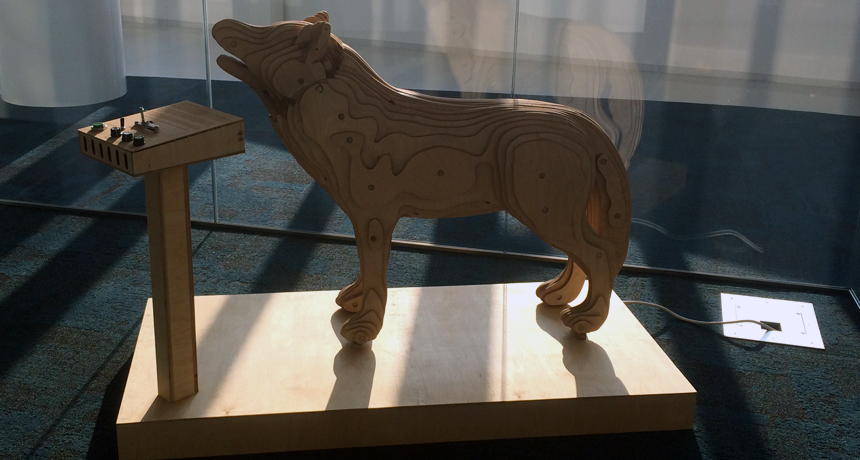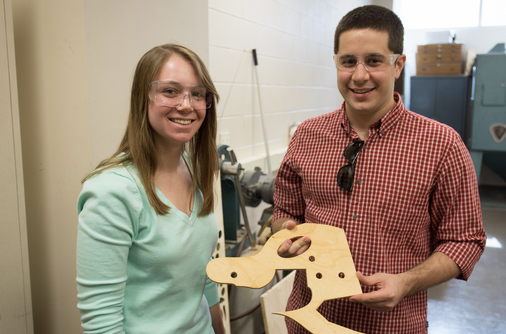Making magic with mechanical engineering
Michelle Phillips pursued her passion all the way to Universal Studios

Michelle Phillips and Kevin Young made this animatronic wolf, which “howls” in the NC State library.
M. Phillips
When she started college at North Carolina State University in Raleigh, Michelle Phillips, was completely certain she was going to be a biomedical engineer. She had attended a local biotechnology summer camp after her sophomore year of high school. “We toured the Wake Forest University Institute for Regenerative Medicine and they had a 3-D printer, she recalls. “It was printing a heart. A real mouse heart. I thought that was the coolest thing I had ever seen.”
But when she got to college, her life took a little turn. Actually, a big one.
Days ago, Michelle, now 22, graduated with a degree in engineering. But she’s not headed for a hospital. She’s on her way to a job at Universal Studios in Orlando, Fla. There she hopes to help make magic happen by building amusement park rides and animatronic figures, robots that move so smoothly you might think they were alive. Meanwhile, she will be leaving behind a legacy at her school: a wolf that moves on command in the university library.
How did Michelle move from an interest in biomedicine to getting a summer job working on the Wizarding World of Harry Potter? She tried out doing what she thought would interest her — and when it didn’t, she looked back to a childhood passion.
On to entertainment engineering
With initial plans to go into biomedical engineering, Michelle knew that she needed to get hands-on laboratory experience. So during her freshman year of college, she found a lab doing tissue engineering. People there were manipulating cells to improve or replace the way people’s bodies function. Unfortunately, a summer spent working in the lab made Michelle realize that biology just didn’t move her. But in the corner of the lab she saw “this crazy machine someone had designed to run experiments.” She decided to try working on that. And quickly she found “I loved it much more.”
By then, Michelle realized that she was excited by mechanical engineering: building machines and figuring out how they work. But she didn’t realize what machines she wanted to build until she watched Randy Pausch’s last lecture. He talked about his experience as an engineer, someone who applies science and math to solve technical problems. “And I realized what I loved as a kid was going to theme parks and seeing the favorite characters from movies and TV shows.” The rides, scenery and animals looked real, she recalled, but they were “just feats of engineering.”
And that was her eureka moment: The college sophomore realized she wanted to build rides for theme parks. And she has never looked back.
She quickly started studying mechanical engineering and hunting around the Internet. Along the way, she found competitions to design rides and the animatronics used at theme parks. Among them was Disney Imaginations. This competition invited college juniors and seniors to submit their best ideas for Disney parks. As a college sophomore, “I wasn’t old enough,” Michelle says. “So I started finding people who had tried the competition before and got their advice. And then I got together a team.” The next year, her team was ready.

It designed a Disney experience in a country that doesn’t have a Disney park. Michelle and her team focused on Rio de Janeiro in Brazil, creating characters that integrated Brazilian culture. They had the mischievous character Saci steal Mickey’s sorcerer’s hat. Then all the Disney characters have to chase after him. All run through different worlds, each ruled by different Brazilian characters. The ambitious project made it to the semi-finals of the competition.
But Michelle didn’t want to hang all her hopes on a single competition. So see looked for professional groups that might offer guidance — and improve her chances. A student at NC State told her to join the International Association of Amusement Parks and Attractions. She did immediately. Then she went to its annual meeting. There ride makers show off their newest designs, trying to get a big theme park to buy them.
Someone in that association suggested Michelle also try joining the American Society for Testing and Materials, or ASTM. It’s a group that helps to enforce safety standards on products, including those used in amusement parks. It has a group responsible for safety standards in park rides, from trampolines to Disney’s famed Space Mountain rollercoaster. Michelle learned that as a student, it wouldn’t cost her anything to join. She did and quickly attended one of its meetings. Her goal: introducing herself to as many people in the amusement-park industry as possible.
“I was standing in the hallway of the conference with three other girls,” she recalls. Suddenly, “the senior vice president of Universal walked up to us and said ‘We need more women in the industry. Here’s my card. Contact me!’” He didn’t have to ask twice. Michelle sent in her resume and asked about opportunities for her to work at the company. The next thing she knew, she had a summer job at Universal Studios. She was assigned to an engineering project on what would become an expansion of The Wizarding World of Harry Potter.
“It was a blast,” Michelle says. She was particularly impressed with how the projects at Universal combined many disciplines working together; something that she says also had been emphasized at NC State. The engineers worked with computer designers and with people making the costumes and designing sets. “Everyone worked together to make this magnificent expansion” To the Harry Potter exhibit.
After such a wonderful experience, Michelle wanted to could come back and work full time. So, “I made sure to keep in touch with the people I worked for,” she says. When she attended the ASTM annual meeting the next year, she made a point to find and meet more people from Universal Studios. She told each how much she wanted to come back and work for them. And all of that hard work paid off. Michelle is now moving back to Orlando for a full time job at Universal Studios.
And what about the wolf? At NC State, there is a University Honors Program. It brings in students with outstanding high school and college grades to conduct research at the school. Each member of the program has to complete a major project before they graduate. Michelle worked with fellow student Kevin Young to bring an amusement ride onto the campus. While they couldn’t quite manage a rollercoaster, the two built an animatronic version of the school’s mascot: the wolf. This mechanical one turns its ears back and tips up its head to howl on command. “Unfortunately,” she laughs, “they wanted to put it in the library,” so no real howling is allowed.
Michelle worked hard to get where she’s going. But, she notes, after she found her passion, what mattered most was meeting the right people. “Networking is one of those buzzwords that people like to throw out,” she says. But it’s really “just meeting cool people doing cool things who can tell you about their experience. And maybe help you out.” So, she recommends finding people doing jobs a student might like to also do. “Then ask these experts about their job — what they like about it and what they don’t like” she says. “It’s just having conversations.”
Power Words
animatronics Using mechanical engineering to create robotic animals — from wolves to dinosaurs — that move in a way that is realistic. Instead of jerky movements that are characteristic of robots, animatronics have smooth movements that can be done in sequence or at random, giving the robot a lifelike appearance.
biomedical engineering Combining engineering and biology to aid human health. Professions in this field develop artificial limbs, use biotechnology to produce new drugs and develop models to understand how diseases work.
biomedicine The field of research that explores the biological basis of injuries or disease and their treatments.
biomedical engineer An expert who uses science and math to find solutions to problems in biology and medicine. For example, they might create medical devices such as artificial knees.
biotechnology Using a living system, such as cells or plants, to make a useful product. Examples include using bacteria to produce human insulin for diabetes, modifying plant chloroplasts (food-making parts of a plant cell) to produce vaccines or using human cells to produce skin to help burn victims.
mechanical engineer An engineer who designs, builds or operates machines or mechanical systems.
mechanics The study of how things move.
networking Linking things or people together to transmit information. A network could be a connection between computer parts, or a group of people who know each other.







